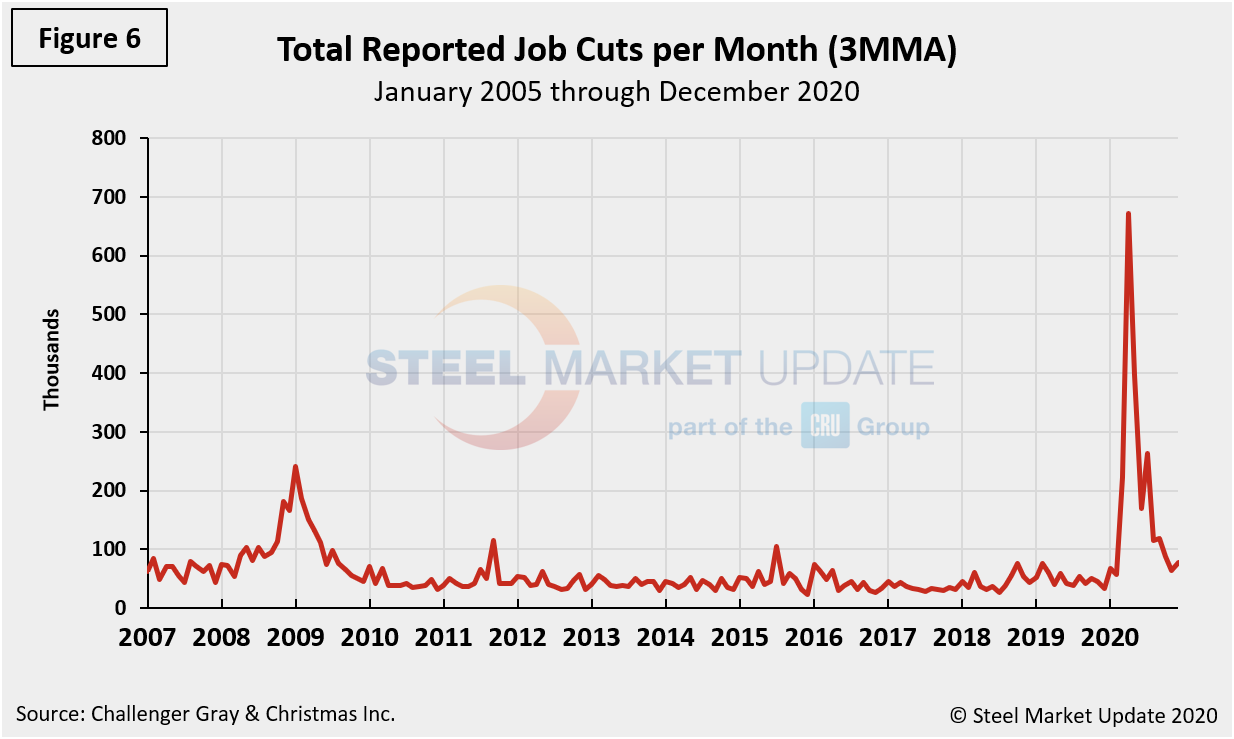Market Data

January 8, 2021
Employment Backpedals in December
Written by David Schollaert
The economy lost 140,000 jobs in December after seeing repeated gains month on month since May, reported the Bureau of Labor Statistics (BLS). The pace of job additions had slowed significantly in November compared to October when additions were 245,000 and 638,000, respectively. The change in direction comes as the market enters the winter months and the pandemic is feared to surge and further impact the U.S. economy and job creation. In December, nonfarm employment was below its February level by more than 9.8 million, or 6.7 percent. Figure 1 shows the total number of nonfarm employed people in the U.S. since 2000.

“Total nonfarm payroll employment declined by 140,000 in December, and the unemployment rate was unchanged at 6.7 percent,” said the BLS. “The decline in payroll employment reflects the recent increase in coronavirus (COVID-19) cases and efforts to contain the pandemic. In December, job losses in leisure and hospitality and in private education were partially offset by gains in professional and business services, retail trade, and construction.
“Construction added 51,000 jobs in December, but employment in the industry is 226,000 below its February level. Residential specialty trade contractors rose by 14,000 and residential building by 9,000. Manufacturing employment increased by 38,000, while job gains in motor vehicles and parts, plastics and rubber products, and non-metallic mineral products were seen. Despite gains over the past 8 months, employment in manufacturing is 543,000 below its February level,” the BLS concluded.
Figure 2 shows the historical picture for the duration of unemployment since January 2005 broken down into < 5 weeks, 5 to 14 weeks and > 15 weeks. The total number unemployed was 10,404,000 at the end of December, an increase of 140,000 compared to November, but down by nearly half or 10,110,000 from May’s historical high. As of Dec. 21, 51.7 percent had been unemployed for more than 15 weeks, 21.3 percent for 5 to 14 weeks and 27.0 percent for less than 5 weeks. In December, the number of unemployed persons increased by 140,000 compared to November, the first increase in the past seven months.

The official unemployment rate, U3, reported in the BLS Household survey (see explanation below) increased from 3.5 percent in February to 14.7 percent in April and recovered to 6.7 percent in December. The more comprehensive U6 unemployment rate, at 11.7 percent in December, improved from 22.8 percent in April (Figure 3). U6 includes individuals working part time who desire full-time work and those who want to work but are so discouraged they have stopped looking.

The labor force participation rate is calculated by dividing the number of people actively participating in the labor force by the total number of people eligible to participate. This measure was 61.5 percent in December, unchanged month on month but up from 60.2 percent in April, yet still below pre-pandemic levels from January and February when the rate was 63.4 percent. Another gauge is the number employed as a percentage of the population, which we think is more definitive. In December, the employment-to-population ratio was 57.4 percent, unchanged since October but up from the low point of 51.3 percent in April, yet still below 61.2 percent seen in January. Figure 4 shows both measures on one graph.

Initial claims for unemployment insurance are reported weekly by the Department of Labor. The pandemic effect began in the week ending March 21 when new claims shot up from 282,000 in the previous week to 3.3 million. The peak for claims was 6.9 million in the week ending March 28. Since then new claims have fallen steadily to 712,000 in the week ending Nov. 28, but have since increased to 787,000 in the week ending Jan. 2. New filings are still higher than they were at the peak of the Great Recession. Figure 5 shows the four-week moving average of new claims since January 2007.

HR firm Challenger, Gray and Christmas Inc. produces a monthly employment update for the U.S. and reported that job cuts in December were 77,030, up 18.9 percent from the 64,797 in November, which was the second-lowest monthly total for 2020. The three-month moving average (3MMA) has declined in each of the last six months.
“December’s total is 134.5 percent higher than the 32,843 cuts announced in the final month of last year,” Challenger reported. “In 2020, 2,304,755 job cuts were announced, 289 percent higher than the 592,556 cuts announced in 2019. It is the highest annual total on record, and 17.8 percent higher than the previous record high of 1,956,876 cuts recorded in 2001. Despite the jump in monthly cuts, the fourth quarter saw the fewest job cuts of the year with 222,493, down 55.3 percent from the 497,215 tracked in Q3 2020. It is 74.2 percent higher than the same quarter in 2019, when 127,687 cuts were recorded. With the exception of the quarterly totals in 2020, it is the highest quarterly total since Q3 2011, when 233,258 job cuts were announced.
“In the final months of the year, companies that may have survived the initial impact of the pandemic in March and April determined staffing adjustments based on increasingly difficult market conditions. While some segments were up, such as warehousing, shipping, financial, and some manufacturing segments, many others were hurt considerably,” Challenger concluded.
Figure 6 shows the monthly job cuts reported by Challenger on a 3MMA basis since January 2007.

SMU Comment: U.S. initial claims for unemployment insurance unexpectedly fell but remain extremely high. New filings fell from a revised 790,000 to 787,000 in the week ended Jan. 2. Although claims were lower, it’s not expected to be a sign of improvement in the job market. February 2020 was the all-time high for nonfarm employment in the U.S., but since then the job market has been reeling from the effect of the pandemic. The winter months are expected to bring about a resurgence in Covid-19 cases, and thus further deteriorating employment statistics. Employment drives consumer spending, GDP and ultimately steel demand.
Explanation: On the first Friday of each month, the Bureau of Labor Statistics releases the employment data for the previous month. Data is available at www.bls.gov. The BLS reports on the results of two surveys. The Establishment survey reports the actual number employed by industry. The Household survey reports on the unemployment rate, participation rate, earnings, average workweek, the breakout into full-time and part-time workers and lots more details describing the age breakdown of the unemployed, reasons for and duration of unemployment.
By David Schollaert david@steelmarketupdate.com







